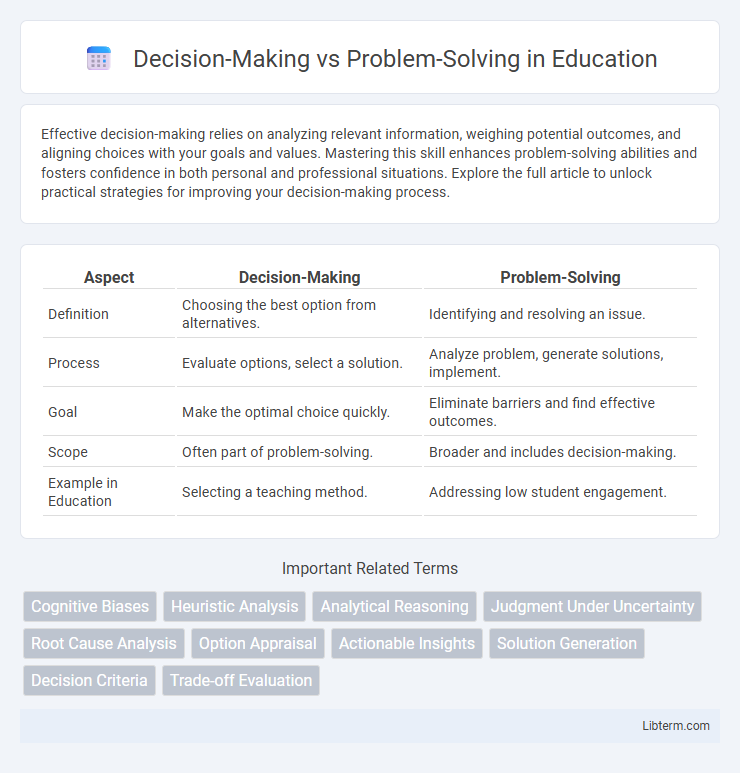Effective decision-making relies on analyzing relevant information, weighing potential outcomes, and aligning choices with your goals and values. Mastering this skill enhances problem-solving abilities and fosters confidence in both personal and professional situations. Explore the full article to unlock practical strategies for improving your decision-making process.
Table of Comparison
| Aspect | Decision-Making | Problem-Solving |
|---|---|---|
| Definition | Choosing the best option from alternatives. | Identifying and resolving an issue. |
| Process | Evaluate options, select a solution. | Analyze problem, generate solutions, implement. |
| Goal | Make the optimal choice quickly. | Eliminate barriers and find effective outcomes. |
| Scope | Often part of problem-solving. | Broader and includes decision-making. |
| Example in Education | Selecting a teaching method. | Addressing low student engagement. |
Understanding Decision-Making: Key Concepts
Decision-making involves selecting the best course of action among multiple alternatives based on evaluating possible outcomes, risks, and benefits. Key concepts include identifying objectives, assessing available information, considering constraints, and predicting the impact of decisions on goals. This process is essential in both individual and organizational contexts for effective strategy implementation and resource allocation.
What Is Problem-Solving? An Overview
Problem-solving is a systematic process aimed at identifying, analyzing, and resolving obstacles that hinder goal achievement. It involves defining the problem, generating possible solutions, evaluating alternatives, and implementing the most effective strategy to overcome challenges. Effective problem-solving enhances critical thinking, creativity, and decision-making skills in various personal and professional contexts.
Core Differences Between Decision-Making and Problem-Solving
Decision-making involves selecting the best option from a set of alternatives based on criteria and preferences, while problem-solving focuses on identifying the root cause of an issue and developing effective solutions to address it. Decision-making emphasizes choice and consequences, whereas problem-solving emphasizes diagnosis and resolution. Key distinctions include the decision-making process being goal-oriented and choice-based, compared to problem-solving's analytical and solution-driven approach.
The Role of Information in Decision-Making
Effective decision-making relies heavily on the accurate collection and analysis of relevant information to identify viable options and predict outcomes. Decision-makers must prioritize data quality, timeliness, and completeness to reduce uncertainty and enhance judgment accuracy. Integrating diverse information sources supports informed choices that align with strategic objectives and mitigate risks.
Steps Involved in Effective Problem-Solving
Effective problem-solving involves clearly defining the problem, gathering relevant information, and generating multiple potential solutions. Evaluating alternatives based on feasibility, risks, and benefits ensures the selection of the most viable option. Implementing the chosen solution followed by monitoring and reviewing outcomes optimizes success and continuous improvement.
Cognitive Processes Behind Each Approach
Decision-making involves evaluating options and selecting the best course of action based on judgment, risk assessment, and predicted outcomes, engaging cognitive processes such as critical thinking, reasoning, and prioritization. Problem-solving requires identifying the root cause, generating possible solutions, and implementing strategies, relying heavily on analytical thinking, creativity, and metacognition. Both processes utilize executive functions in the prefrontal cortex but differ in focus: decision-making centers on choice evaluation, while problem-solving emphasizes overcoming obstacles through systematic reasoning.
Decision-Making in Real-World Scenarios
Decision-making in real-world scenarios involves selecting the best course of action from multiple alternatives, often under conditions of uncertainty and limited information. Effective decision-making relies on critical thinking, risk assessment, and prioritization to achieve desired outcomes in complex environments such as business, healthcare, and public policy. Incorporating data analytics and stakeholder input enhances the accuracy and impact of decisions, driving strategic success and operational efficiency.
Problem-Solving Techniques and Best Practices
Effective problem-solving techniques include root cause analysis, brainstorming, and the use of decision trees, which help identify underlying issues and generate viable solutions. Best practices emphasize a structured approach such as defining the problem clearly, gathering relevant data, exploring alternatives, and evaluating outcomes through metrics like cost-benefit analysis or impact assessment. Incorporating collaborative tools and continuous feedback loops ensures adaptive refinement and successful resolution of complex challenges in decision-making contexts.
When to Use Decision-Making vs Problem-Solving
Decision-making is ideal when selecting the best option from a set of alternatives, especially in situations requiring immediate action or where choices are clearly defined. Problem-solving should be employed when identifying the root cause of an issue and developing a systematic approach to resolve complex challenges. Use decision-making for quick, outcome-focused choices and problem-solving for in-depth analysis and structured resolution.
Enhancing Skills: Improving Both Approaches
Enhancing decision-making and problem-solving skills involves practicing critical thinking and analytical reasoning to evaluate options and identify effective solutions efficiently. Employing techniques such as scenario analysis and root cause identification sharpens cognitive abilities, leading to better outcomes in complex situations. Regular reflection and feedback integration further refine these skills, promoting continuous improvement in both approaches.
Decision-Making Infographic

 libterm.com
libterm.com